The intention of this writer is not to write a test of the Wrangler, but to write the best test of the Wrangler in Spanish (to achieve it is another thing). The two units tested are automatic transmission, on the one hand the 3.6 V6 Pentastar 284 hp (petrol) and on the other the 2.8 L4 CRD 200 hp (diesel). In both cases they are short bodies (Wrangler) and in terms of equipment, are two special series, an X and a Backcountry. They are quickly distinguishable by the vinyls.
The Wrangler is already a very veteran model, which survives in the market with the incentive of special editions one after another, in addition to the three usual versions: Sport, Sahara and Rubicon. It sells reasonably well, despite how expensive it is, and not only as an SUV, there are also people who buy it to posturear, as the one who buys an SUV. I didn't want to insult the legend, and that's why in less than an hour after picking up each car, I'd already dunked them in the mud, as God intended.
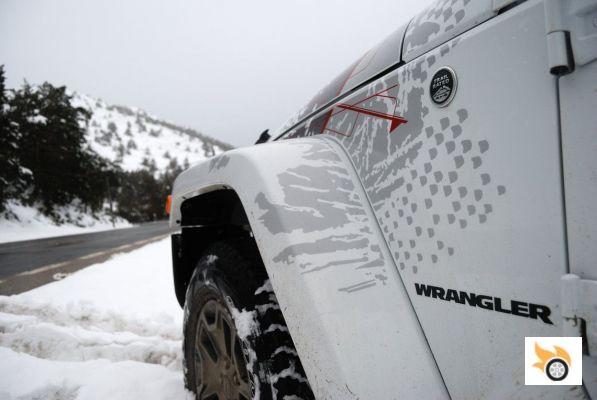
Allow me a brief retrospective. The civilian Jeep, the CJ series, was sold from 1946 to 1986. In our country it was manufactured under license by VIASA in 1959, like so many other cars of foreign origin. The Wrangler as such began its commercial life in 1986, with the YJ series. The second generation arrived in 1997, with code TJ, and numerous technical advances. The current generation is the third, the JK, and dates from 2007. Yes, it's already a few years old...
The Jeep Wrangler shows its age due to details such as the absence of daytime running lights (as it was homologated before it was mandatory), monochrome computer screens with bright green or the "quality" of finishes typical of Chrysler before FCA put their hands on it. In 2011 came a restyling that improved the interior considerably, upped the power of the diesel engine and fixed some bugs.
In 2011 came Cherry Red, Crystal Red, Detonator Yellow, Sahara Toast, Cosmos Blue and Brilliant White.
Since then, it has had special series galore, namely 70th Anniversary Edition (2011), Arctic (2012), Mountain (2012), Moab (2013), Rubicon 10th Anniversary (2013), Polar (2014), Rubicon X (2014), X (2015), Black Edition (2015) and Backcountry (2016). They differ in aesthetic details and some improvement in equipment over the usual versions, and, obviously, by a limited production units. Partly, yes, it's a bit of marketing, but it works.
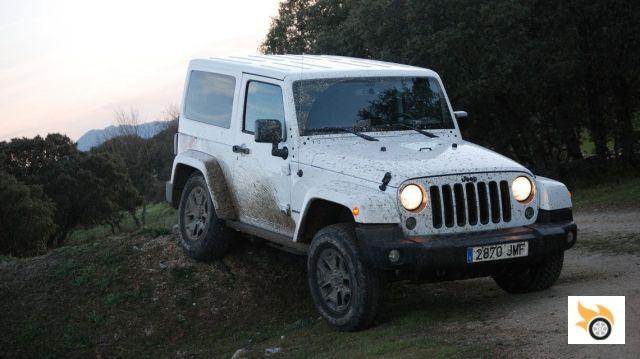
Design
The Wrangler is a model that respects its ancestors, like the Porsche 911, Fiat 500 or Volkswagen Beetle (with the inevitable concessions to modernity). The seven-slot grille comes from the first Jeep, as well as the round headlights, trapezoidal wheel arches, visible hinges, folding windshield (Rubicon only), removable doors and roof, roll guards, hood fastening by pins, etc..
You can quickly tell the petrol from the petrol, because the diesel has the heat exchanger in front of the radiator, and can give the impression that it is prone to overheating. In fact, the bonnet has some extra air vents on the CRD. During the test, which was not done in very hot weather, the temperature was totally under control, even abusing the reduction gear and at low speed.
You can get the car "naked" by removing the roof and doors, even the windshield if you have the patience and tools.
Of the three types of roof (canvas, plastic and mixed) this one has the plastic one, called Freedom Top. You can remove the front in two sections (driver and passenger) and the rear in one piece. For the two small sections you don't need tools or strength, but to remove the rear roof you need the help of another person, and more patience. The windshield wiper connections and the heated window have to be removed, but it's all taken care of. There are holes for the screws, so as not to lose them, and a cap prevents washer fluid from leaking.
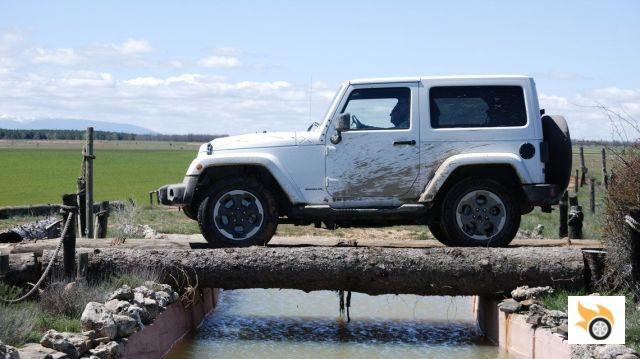
The bonnet is opened by releasing two side hooks, which are very clumsy for a modern car, and then lifted and fastened with a rod. It can be seen that the bonnet is prepared for a considerable dive, because the air intake is very high up. The bonnet fastening mechanism leaves something to be desired, because at highway speeds it vibrates considerably, and the driver may have the impression that it is going to fly off at any moment. Fortunately this is not the case.
No provision has been made to carry the detachable parts on board, so it's easy for them to get scratched or broken if they're loose in the boot.
Don't think of the Wrangler as a convertible. Removing the driver's side makes it uncomfortable under 60mph, especially if you roll down the windows. Removing the two is a little less annoying, but it must be like going without a roof. As soon as I picked up the first unit, I drove without the roof, but I'm very given to uncovering anything I have the opportunity. The sound system has plenty of power to dampen aerodynamic noise.
Let's keep in mind that the aerodynamics of this car are terrible, one of the reasons why it wastes so much money. But the design is cool and timeless. It's not necessarily practical, and you can see that in the boot. To access it we can open the opening window (upper half), or open the tailgate, which needs a lot of space at the back. The short body has a capacity like the most bare of the utilitarian, a minivan 5 + 2 with all seats up, or a roadster: only 141 liters. For four people this is clearly insufficient, and nothing covers the luggage. However, the spare wheel and the windscreen wiper motor significantly reduce visibility.
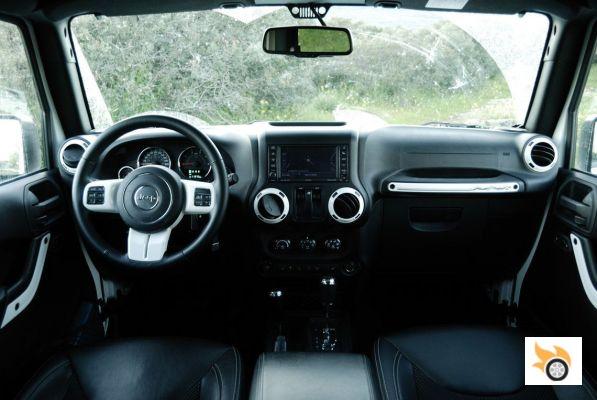
Passenger compartment
Fortunately for Jeep, Fiat took over Chrysler after the near-bankruptcy of 2009, and did some much-needed interior tuning. The Wrangler JK was designed when Chrysler (with Jeep and Dodge) had interior quality more worthy of Dacia. It was common to find plastic cutting edges, exposed wires, surfaces harder than Chuck Norris' face, poor finishes... I have lousy memories of the Dodge Caliber and Chrysler 200C Sebring, even the 300C was lacking for a car of its price.
In 2011 the Wrangler received, among other things, a more modern multifunction steering wheel, updated instrument panel (something was something), more storage compartments, higher quality materials, a new center console, electrically adjustable mirrors (previously they were adjusted by hand) and heated, a noticeable improvement in sound insulation, larger windows and modern things like USB connector or Bluetooth. The 2007 model was rougher and more spartan than the current model.
But after that improvement it continued to accumulate design flaws that were already inexplicable in 2007. There's no footrest for the driver, so we won't know what the hell to do with our left leg, especially in automatics (there's no clutch pedal). The folding seats have fish memory, that is, you have to adjust them every time you use the folding mechanism. Access and exit to the rear seats is uncomfortable and requires a minimum of agility. There is not much space in the back either, neither for the legs nor for the feet, but the width is good because it is a four-seater.
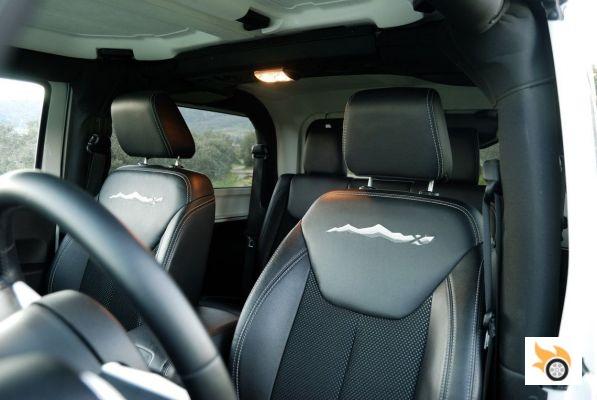
Both in the special edition X and Backcountry the seats are leather with specific motifs and contrasting grey stitching. The interior images are for the X, which has white inserts, while the Backcountry has gloss black. The Mopar floor mats are made of rubber studs and won't complain even if we get in with muddy boots and moss, they can be washed with a hose. In general it is easy to clean something if there is an "accident", such as going through a deep puddle at 50 km / h with the roof off.
The doors and tailgate need a minimum of force to close properly.
Those who want a minimum of comfort for the rear occupants, as well as a proper boot (almost 500 litres) will have to opt for the Jeep Wrangler Unlimited, i.e. the four-door, five-seater version. Having the longer wheelbase and rear doors, the life of the rear occupants improves a lot, and also the behavior of the car is more stable on the road. On the other hand, the short version is almost 3,000 euros cheaper, is much more agile and consumes less fuel as it weighs less.
The driving position is a bit hard to find. I tried to keep my left leg fully extended, or to go half seated, but I didn't feel comfortable at any time. The steering doesn't adjust in depth, only in height. In the end the driver will have to try to raise the seat and vary the inclination of the backrest to go well, but then the adjustment will go to hell when someone has to get in the back. An intermediate solution is not to allow anyone to get in on the left side, so the adjustment remains.
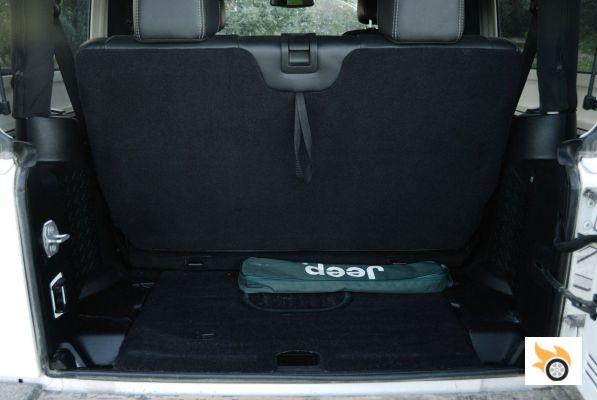
Good thing they gave it an acoustic treatment in 2011, because it's a noisy car. Both the 3.6 V6 and the 2.8 CRD transfer noticeable noise to the cabin, only the petrol can be forgiven because it roars like hell. As for the petrol engine, there will be those who hate it, or those who are turned on by it. Engines with such big cylinders are ideal for off-road driving, but they are not the best for those who suffer from fuel consumption. Both sound like a fat engine, they don't go unnoticed.
The rolling sound is also clearly perceived, because it has tyres suitable for the type of car it is. A Wrangler with 100% road tyres is like seeing a heavy metal singer dressed in Armani, a contradiction in terms. Both the Goodyear Wrangler and the Bridgestone Dueler are M+S, they make noise, and make it difficult to fall asleep. If someone falls asleep driving in a Wrangler at 100-120 km/h they have a serious problem that should be looked at by their GP as soon as possible.
It also imposes air noise, since by definition, it is an anti-aerodynamic design. As a good American car, it's designed to waste fuel, after all, any developing nation can provide broth for it to drink. Those square and vertical surfaces are the worst thing on the road. It doesn't invite you to go fast at all. The engines are noisy, the wind is noisy, and as soon as you stop going in a straight line there's a certain dynamic instability. But I'll talk about that later.
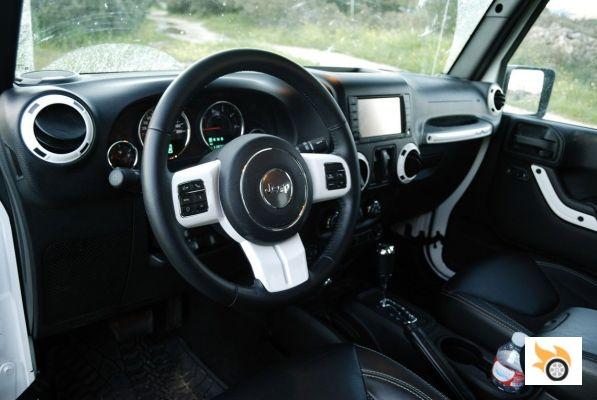
On a practical level, it's not that there's not a lot of storage space, but at least it has two glove compartments with a generous capacity, and both can be locked. Of course, the documentation and instructions of the car almost completely unusable in the central glovebox, because in the passenger's glovebox it doesn't fit. In the doors and in front of the gearbox there are some nets for small objects. For example, in front of the gearbox I left a Walkman, with which I was listening to old Rolling Stones tapes to feel like the p**o master driving this SUV complexer.
The UConnect multimedia system allows you to use the touchscreen with gloves on.
The door netting can easily accommodate a record player, where I could bring, depending on my mood, the best of Detroit and Los Angeles niggas, quality electronic music (Radical Gold and the like), a DVD concert to cry with pleasure (there's a picture in "P", not in gear) and House for when I was feeling low (i.e. when the reserve went off). It has a USB connector, Bluetooth Audio and a 40 GB hard disk, so it will be for music listening possibilities. By the way, the Alpine speakers sound so good that they produce auditory orgasms, one after the other. Downside? Yes, I'll throw one in: ripping a CD to hard disk takes a long time, about an hour per disc, but you can listen to the radio or Bluetooth in the meantime.
It's not particularly comfortable in the Wrangler because it has two rigid axles, and when one wheel hits a bug, the jolt is transferred to the rest of the car. I have, however, carried in the two rear seats two tall colleagues who slept like babies on a journey of an hour and a bit. They didn't wake up as if they had been resuscitated, nor with major discomfort. The in-comfort of this car is perfectly acceptable for those who know what car they're in. If you're a bit of a fussy eater, you'd better go for an SUV, because the Wrangler is a car for males. And no one should be offended, please.
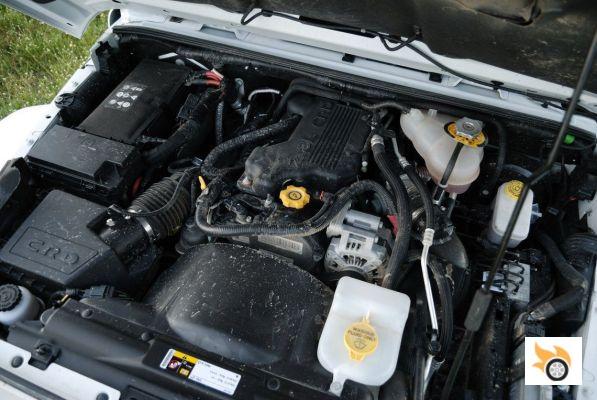
Technology
As a good off-roader and descendant of an SUV tradition, it is designed as such. The body rests on a double-beam chassis with rigid axles and shock absorbers. This type of suspension has a lot of flexibility, especially when driving over rocks or steep slopes, the ground clearance of the differentials remains constant, and the wheels are less likely to be in the air. The wheel arches give hints of the flexibility it has, and, by the way, they protect very well from mud.
The lack of stiffness is noticeable on many occasions, the chassis is not too stiff.
The problem with this configuration is that, on the road, the Wrangler leaves a lot to be desired as a car, but it's worse than a Land Rover Defender in that sense. It doesn't give the driver confidence, it doesn't invite you to go fast (or push the limits), any imperfections in the tarmac are felt throughout the car, and cornering is disappointing to say the least. It's made to go wide off-road, and go where others don't go. Also, braking on urban speed bumps becomes completely optional.
Moving on. The power steering is recirculating balls, it's very indirect and you have to move the steering wheel with a lot of speed if you want to be agile when parking, or taking very slow curves in town. To make a successful counter-steering in a limit situation, you have to move the steering wheel as Bruce Lee would do. It also has an important neutral zone, like an old car, taking your hands off the wheel is a quick way to see Kurt Cobain and have a few heavenly beers with him.
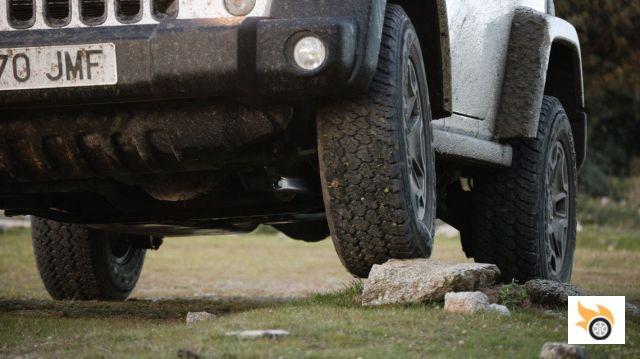
On to the transmission. All Jeep Wranglers have engageable all-wheel drive. By default, they run with two-wheel drive, the rear (4x2H), an optimal configuration for almost any driving condition on asphalt. Lacking a center differential, connecting the front axle (4x4H) the two axles rotate together, hindering the turning radius, accelerating the wear of the front wheels and increasing consumption. Above 80 km / h does not engage, it must be less.
It has a third mode, which is all-wheel drive with reduction gear (4x4L), that any SUV dreams of having. Almost all Wranglers have a 2.72:1 reduction, but the Rubicon has a brutal gear ratio, 4:1, it can race a snail at idle in first gear. In addition, the Rubicon allows you to lock the front and rear differentials, as well as disengage the front anti-roll bar when you get into really tricky places.
In the case of the Backcountry, the rear differential is self-locking.
To change from one mode to the other, you have to move the lever on the left, which requires a lot of force because of how hard it is, I love it! To shift from 2H to 4H you can go in gear, but to shift from 4H to 4L (reduction gear) the transmission must be in neutral by the nose. You can feel the mechanical movements, they didn't want to hide them. Thinking about it gives me an erection.
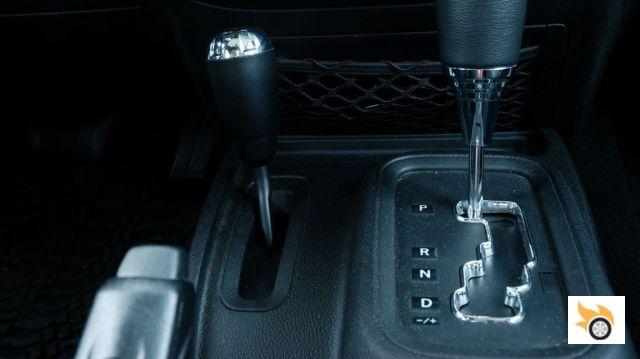
The Wrangler can be chosen with a manual transmission that includes Stop&Start, or with a five-speed W5A580 torque converter and hydraulic clutch automatic transmission. Both units tested had that type of gearbox. The good thing is that it will withstand off-road torture, as if nothing, the bad thing is that consumption suffers a little, and are engines by definition swallowing.
Chrysler fitted a Stop&Start for the first time in the Wrangler!
The automatic gearbox has a very American approach, a bit slow to react, it tends to take the engines very low revs, and when you press the accelerator to the floor, you have time to light a cigarette until it reduces one or two gears. It allows for sequential handling, useful for descending passes or similar situations. With the diesel engine, sometimes you have to push it harder (more throttle) so that it revs up and responds sooner. With the accelerator pedal pressed firmly, it always slows down, even in semi-automatic mode.
The transitions from one gear to another are not particularly abrupt, depending on what is being demanded. It is one of those gearboxes that invite you to insert neutral or "P" when there is a traffic light, because it reduces vibrations significantly. It also seems to scream for sixth gear at times, because the engines have a lot of torque, and could be less revved. The Rubicons have a shorter final downshift for obvious reasons.
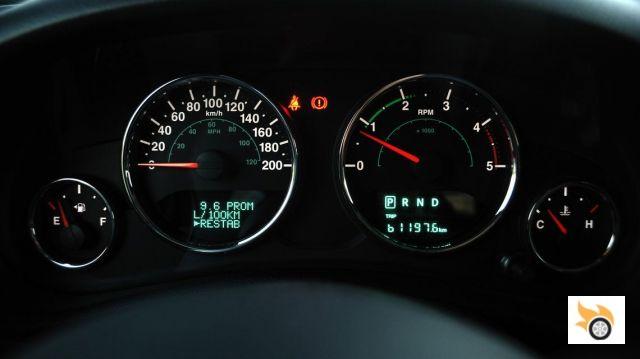
Now it's time to talk a bit about the engines. The most logical choice for the Wrangler is the 2.8 CRD engine, mostly because the consumption in equal conditions is 3-4 l/100 km less, and the tanks last more than twice as long using diesel. Almost all Wranglers in Spain are petrol engines, but some crazy people have chosen petrol when they have been allowed to do so.
The 3.6 V6 Pentastar engine has four valves per cylinder, twin camshafts and indirect injection. It puts out 284 hp at 6,350 RPM, and a maximum torque of 347 Nm at 4,300 RPM. With it, the Wrangler is planted in 100 km / h in 8.1 seconds and gets - if one dares - to reach 180 km / h. The homologated consumption is 11.4 l/100 km, and yes, the real consumption is usually between 12 and 13 l/100 km, and that's without stepping on it and without going over 100 km/h at all. This engine makes the Wrangler relatively quick in a straight line.
The petrol engine does 0-100 km/h in 10.6 seconds and reaches 172 km/h.
The 2.8 CRD is a four-cylinder with piezo injectors, variable geometry turbocharger and heat exchanger. It produces 200 hp at 3,600 RPM (177 hp in 2007), and the maximum torque depends on the gearbox: with the manual it produces 410 Nm (2,600-3,200 RPM) and with the automatic 460 Nm (1,600-2,600 RPM). It is rated at 8.3 l/100 km, and the actual fuel consumption is between 9 and 10 l/100 km of diesel. Both engines pay the maximum registration tax, over 200 g/km of CO2.
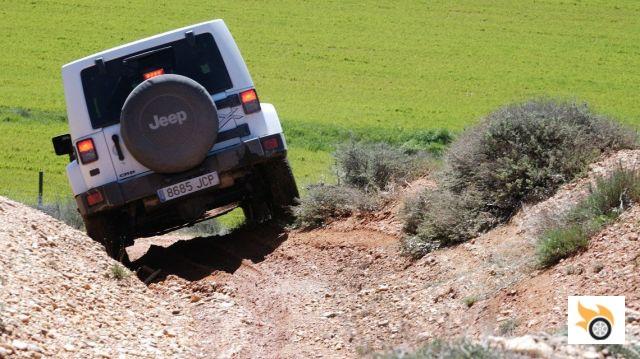
Driving
If you've made it this far, you'll think the Wrangler is a dreadful car and even dangerous to drive. Read on, because that's not the point. If this car is always driven on the road, you've made the wrong choice. You have to choose wisely, like Indiana Jones did with the Holy Grail. If you're not going to go off-road for tricky areas, not dirt tracks that a Saxo would drive over with no problem, this car doesn't make sense.
Its suspension set-up is one of the worst there is for road driving. The body is held as it can in the curves, its potential in sporty driving is zero, in fact, the Transporter that starred in a test recently gives a review on the road impression. It doesn't encourage you to push the limits, nor does it encourage any spirited driving. At the slightest touch the tyres start to squeal, the ESP intervenes (and quickly) and you can feel the brakes screeching to bring the unruly wheel to a halt.
It's not that it doesn't sway excessively, but it lets the driver see that you can't flash at all, nor look for controlled skids with the rear axle because it's propulsion in normal conditions. That's why I give it a behaviour score of 20, without considering its 4×4 abilities, obviously. On the motorway, anything over 140 is apparently madness.
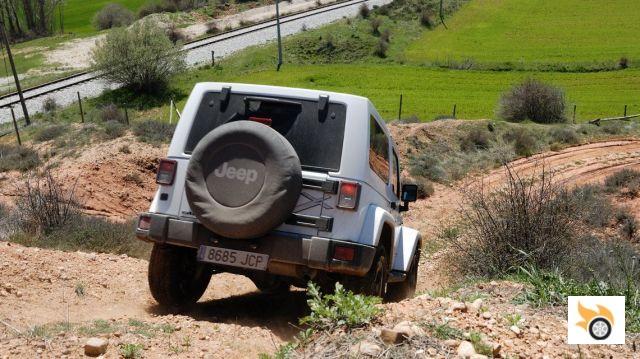
I've driven in a hurry, in the pouring rain, and before reaching any corner my Jiminy Cricket would say "Javier, if you don't brake NOW, you're going to take the corner on two wheels". The car is very informative in that sense, the driver will tend to be more conservative with his corner entry speed if he doesn't want any unpleasant experiences. Real SUVs have these things, this isn't a Porsche Macan, nor does it pretend to be.
ABS skips easily under medium to hard braking.
I found the Goodyear Wrangler tyres on the petrol to be very satisfactory in a broad sense, because they responded well in mud, on tarmac, on stones and on snow. What's more, I drove on virgin snow, quite deep, without any difficulty. A little sliding and the all-wheel drive did the rest. I couldn't find much virgin snow without leaving Madrid, but it's clear that it doesn't seem to need chains when the Guardia Civil closes roads. After all, it's a bloody off-roader. I found the Bridgestone Dueler slightly inferior.
On dirt tracks, I've dared to do with the Wrangler what I would never have thought of doing with an SUV, fearing I'd break the suspension to pieces and have to go into exile in Argentina to avoid the wrath of any press officer. The Wrangler has an endurance in the face of punishment that takes the hiccups out of you. I drove on a dirt track, parallel to a dual carriageway limited to 100 km/h, at the same pace as those on tarmac, and it wasn't exactly a flat surface.
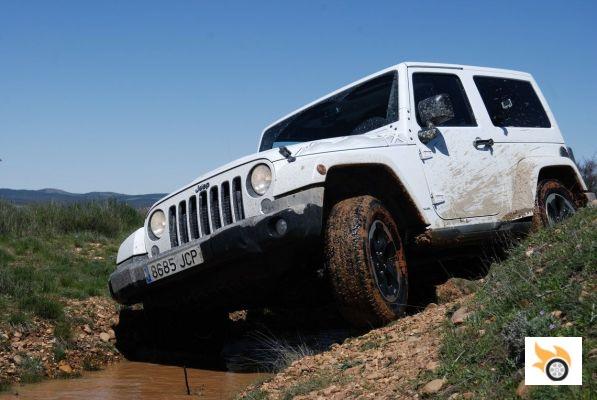
What a good car - like the MX-5, the 911 or the WRX STI - does on tarmac, the Wrangler does off tarmac. Riding fast on a dirt track, in the rain, with mud and gravel everywhere, can only be more fun in a rally car at an official event. The car grips really hard, and the tyres are designed for that. If you hit a big pothole, the tyres are reinforced and the suspension travel and ground clearance make it very difficult for the underbody to take a hit.
The Wrangler's angle of attack is 37.8 degrees (38.1 for Rubicon), the ventral angle is 25.5 degrees, and the departure angle ranges from 29.7 to 31.6 degrees. It makes a fool of any SUV. Ground clearance ranges from 238.8 to 269.2 mm, depending on the tires and whether or not it's a Rubicon. In terms of fording capability, it's over half a metre. These are serious words, my dear friends.
All that glitters is not gold. You have to brake early, no matter what the surface, because it weighs close to 1.9 tonnes, and the grip is limited and the physics aren't there to be violated. The stability control is very intrusive for our own good, but it has two more levels of less intervention (to each his own). In the intermediate mode it allows you to make nice crosses on dirt, especially with the 284 hp petrol, which has a lot of power and turns up quickly.
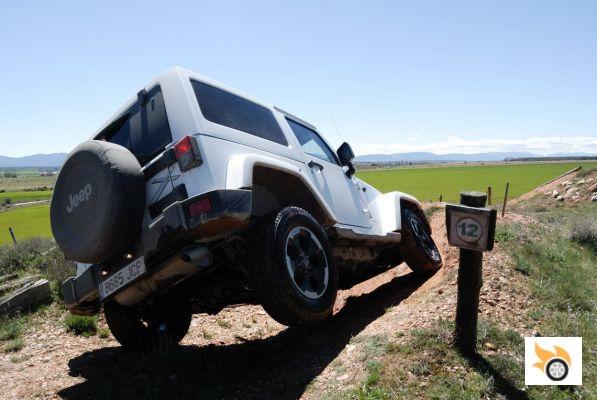
It's worth noting that with all-wheel drive the Wrangler turns less well, and the power steering is uninformative and very indirect. In addition, the driving position is high, the tires have a very high profile, and you can not always properly appreciate what happens under the wheels, but you can get used to it. Thank goodness it has stability control as standard, thank goodness!
On the road, as the chassis is not very rigid, when the roof sections are not correctly fastened, or have been removed, every bump is more noticeable and there are more noises. However, going over 90 km/h is not reckless, which may be debatable when driving the Defender or a first generation Kia Sorento. Its driving dynamics are 80% off-road and 20% touring.
Jeep Wranglers have reserved parking spaces, where some cars would never dare to enter, like pools of thick mud.
When you test the Wrangler on a demanding 4×4 track, like the Bercimuel CPB in the photos, you don't get that impression of a lack of rigidity, even if the car is on three legs. It overcomes obstacles with astonishing ease, and where it's scary to put an SUV, the Wrangler passes with little difficulty. It's very difficult to hit the underbody, or get it stuck, or the suspension to stop. And if it's a Rubicon, it gets in wherever it wants.
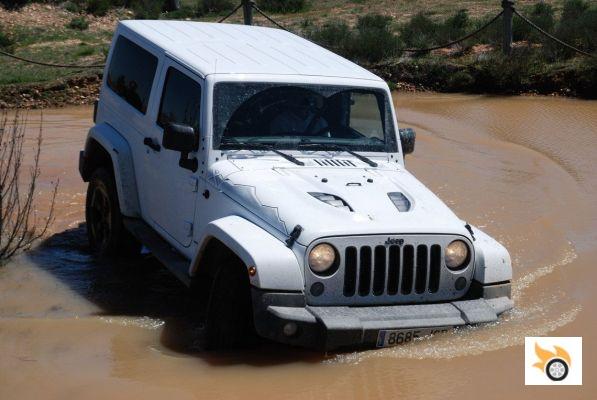
In the images you can see that the Wrangler has undergone all kinds of tests: climbing, descending, V-ditches, mud, snow, rocks, negotiating logs, high lateral inclination, deep fording... By the way, the descent assistant works like a charm, just go down in first gear and you don't have to touch the pedals at all. You just have to concentrate on the steering wheel.
In the absence of self-locking differentials, the Wrangler selectively brakes the wheels to achieve the same effect.
The Wrangler is probably the best off-roader I've ever driven, with the exception of the short Toyota Land Cruiser, which is no slouch. It's the most capable Jeep for off-roading, and I expect it to remain so when the fourth generation comes out. There's the challenge of taming it a bit without losing its legendary off-road capabilities. Pure 4×4's are on their way to extinction, but the Wrangler still holds up.
With this car, every time you see a path parallel to the road, you wonder where it's going, and get in to investigate. If it wasn't for the fact that some unpaved roads are death traps for your wallet if the rangers show up, you wouldn't even need tarmac to drive on. Any driver would have been very happy driving the Wrangler in those days when asphalt had hardly been laid, and everything was wilder.
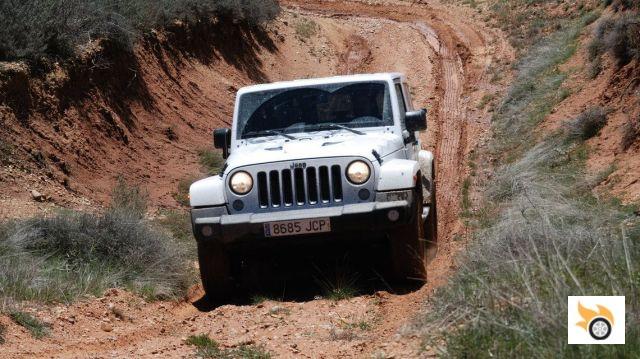
Let's finish this section with some more or less important notes.
You can appreciate the American sense of humour by the "ECO" indicator on the dashboard, which lights up when driving at low revs. The computer shows average fuel consumption, range, driving time, compass (always visible), digital speed, tyre pressure and little else. By the way, you can drive dozens of kilometres without a drop in range if you drive very efficiently. Going under 9 l/100 km in diesel or 12 l/100 km in petrol is possible, but you have to drive very, very quietly, listening to Pablo Alborán or similar, and without going over 100 km/h.
The halogen headlights are not a marvel, but the light sensor is already to feed him apart. Driving during the day, and entering a tunnel, I've timed 14 seconds until the dipped headlights have come on, and with both units, so it's not a specific problem. It's preferable to do it by hand, honestly. It works much better with the rain sensor. No need to look for any more driving aids, it doesn't have one.
As for fuel consumption, you have to be careful. The petrol usually announces a reserve after 300 kilometres, and it warns you in good time because it's a 10.5 litre back-up. The tank is 70.5 litres for the petrol, 66.6 for the petrol. The CRD goes into reserve after 800 km. Another advantage of the diesel is that it has a much more stable fuel consumption no matter what you do, while the V6 can swirl in the tank and eat up petrol. In the long term, the V6 is for switching to LPG (and losing half a boot), or to go broke.
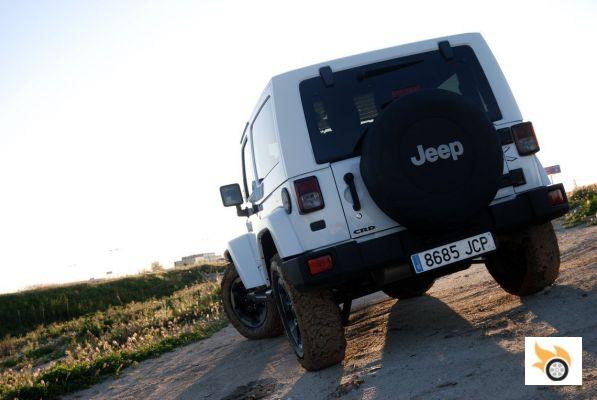
Conclusions
Of all the 4×4's I've driven in my life, the Wrangler has been the one that has made me happiest, and the one I've had the best time driving. For multiple and diverse reasons I ended up doing a lot of miles with these cars, so I made my usual gas station very happy. I enjoyed like a pig, especially in the mud, but I was happy to see that the rain practically cleans these cars. It's all thought out.
The Wranglers are expensive whims, over 30,000 euros, at least they have a very reasonable equipment in which there is usually automatic climate control, steering wheel with controls, UConnect multimedia equipment with GPS and other stuff. This aspect is more careful in the special series, which comes out once in a while, and so it will be until a successor appears and there are firm marketing dates.
If you want a very efficient off-roader, without spending a lot of money on adaptations, the Wrangler is still a very good candidate despite its seniority in the market. If you have to be minimally practical, better the Unlimited, because the short is more for singles, or couples without children. Whoever has a great adventurous spirit, likes the American vibe and wants a car with personality, should also look at it. Whoever wants a big and tall car to go to work, without dirtying it, should buy something else, they will thank me in the end.
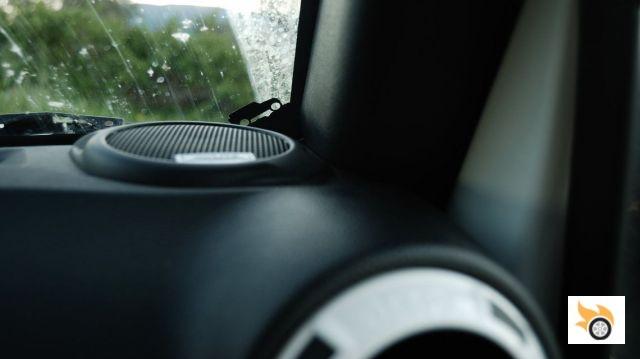
I loved the little details that make it so Jeep, like the floor mats and logos printed on the moon, at the height of the rearview mirror (replicates the grill) and in the lower right corner (in front of the passenger) with a small 4×4 doing its thing. You end up understanding the veneration for the Wrangler when you go to a minimally serious 4×4 concentration, or do a course of the brand. More than one will be amazed at what your car can do.
Special thanks to the Centro de Perfeccionamiento de Bercimuel (CPB), who gave us their 4×4 circuit for the photos.

























